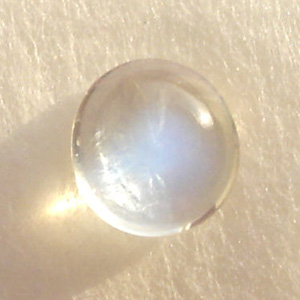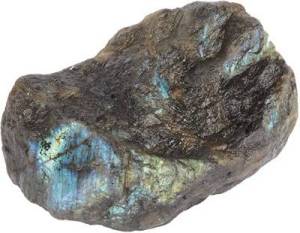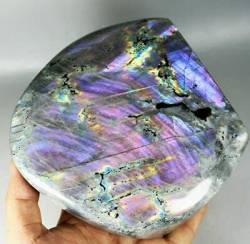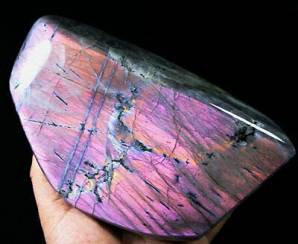Adularescence and Labradorescence are the two main offshoots of the schiller phenomenon seen in some gem minerals. The name schiller originates from the German word for twinkle.
Adularescence manifests itself in moonstone. And this shimmy shows only one color at a time. On the other hand, Labradorescence occurs in the mineral labradorite. It is a multi-color shimmer with a surreal appearance.
Adularescence in Moonstone
Image Source: https://commons.wikimedia.org/wiki/File:Moonston.jpg
Play of Light:
The refraction of light within the interiors of this stone synthesizes the schiller effect. Multiple layers of feldspar belonging to different genera populate the gem’s interior. What you have here is a virtual mineral sundae. The Diverse feldspars bring a ragtag of refractive indices into the gemstone. Consequently, light rays bend at different angles while passing through these various mineral layers.
Splitting of Light Into Constituent Colors in Case of Labradorescence:
Additionally, each layer absorbs and emits a different color of the spectrum. Light sundered in this manner projects the dancing schiller effect onto the gem’s surface. Furthermore, the differential refraction of light can also cause a lustrous rainbow-like play of color known as iridescence.
Nature parades a similar show of colors on oil-slicks, soap-bubbles, fish scales, and many other surfaces. Likewise, iridescence also causes that peculiar color-shifting quality in pearls.
Just as some specimens of labradorite exhibit this beautiful play of color called labradorescence, so too moonstones display a twirl of light known as Adularescence.
7190 Ct. Labradorite Rough Gemstone
Click On The Image
Difference Between Adularescence and Labradorescence:
Labradorescence is essentially different from Adularescence in that labradorescence can project multiple colors simultaneously.
Therefore, if someone shows you a rainbow moonstone, a test of its refractive index would instead confirm it to be labradorite. So, though the gem looks like moonstone, it is a different mineral belonging to the same family of minerals.
Moonstone indeed shows you one color at a given time. Nevertheless, different moonstones can have different schiller colors. Furthermore, stones showing blue schiller command the highest prices. Besides blue, there are green, red, and other schiller colors. The stone’s body color could also differ, or it could be completely transparent.
Spectrolite:
Finland supplies us with top-notch quality labradorite called spectrolite. The mineral from this region is rugged and relatively rare. The opaque base of this mineral strain amplifies its schiller color. As a result, Finnish labradorite shows stronger & richer colors.
The word spectrolite originates from the word specter, which means a ghostly apparition. The haunting aura of the schiller reflection progenerates this word.
4.67lb Polished Rainbow Purple Flash Labradorite Spectrolite Form Crystal
Click On The Image
Summation:
Feldspar minerals like labradorite or moonstone typically host the schiller effect. However, it occurs in certain other minerals also.
Light passing through thick and thin feldspar layers with different chemical makeup causes the schiller effect. Light bends and refracts and further splits into its component colors while passing through these tightly sandwiched layers. The intricate gymnastics of light rays create the schiller effect consisting of Adularescence and Labradorescence.
4.21lb Polished Nice Rainbow Purple Flash Labradorite Spectrolite Reiki Stone
Click On The Image
See More Phenomenal Gemstones As Follows
| Phenomenal Gemstones | Asterism in Star Gemstones |
| Chatoyancy | Gemstone Fluorescence |



